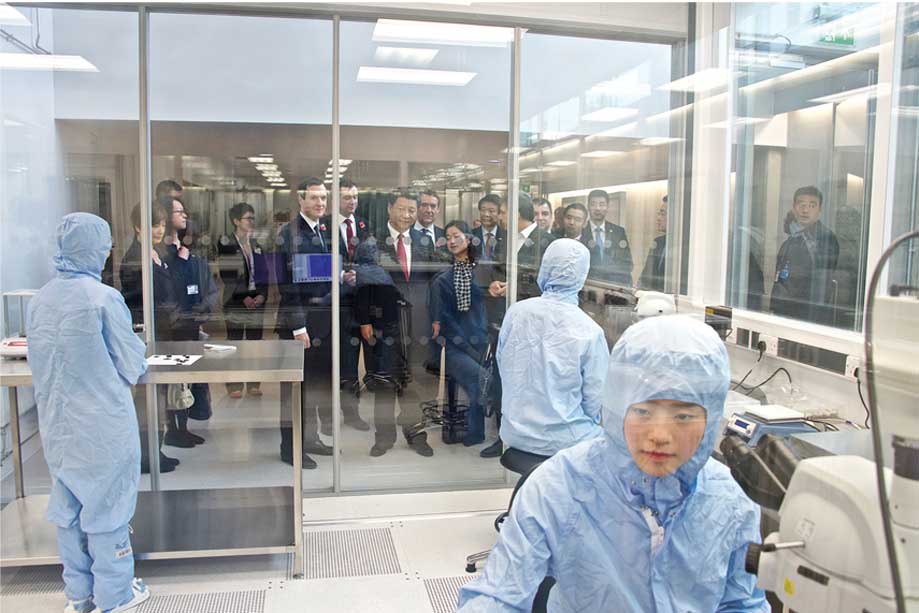Advanced materials have the potential to revolutionise our lives, from wearable electronics to ultrasensitive sensors. At Manchester, our pioneering work with 2D materials such as graphene has placed us as world leaders with the capability and research power to respond to industry's needs, creating the materials that they want next.
In our labs, a revolution is gathering momentum. The two-dimensional (2D) materials in development here have captured the attention and imagination of scientists, researchers and industry around the globe. Sparked by graphene, the possibilities are endless. These advanced materials will help to solve some of the world’s most critical problems in ways not previously thought possible: removing the pollutants from water to provide clean drinking water to millions of people; blocking carbon emissions using a 2D membrane; or making computers faster and quicker by reducing the size of their circuits. They’ll define a new age.
At Manchester, we’re busy working with a wide range of partners to bring this age about. We’re researching the materials that can meet industry’s needs, pushing their applications closer to commercial reality.
2D to order
Graphene, the world’s first 2D material, has opened the doors for the exploration of others, shifting the gears of the materials science landscape. Graphene was first isolated here, at The University of Manchester, by Nobel Prize-winning professors Sir Andre Geim and Sir Kostya Novoselov. No other material has the same breadth of application: lightweight aircraft; electric sports cars; flexible mobile devices and targeted drug delivery to name only a few.
But research at the University has now evolved from the initial work on simple graphene to new 2D crystals: hexagonal boron nitride, tungsten disulphide, molybdenum disulphide and more.
Manchester is leading the world in developing new and existing materials, measuring and exploring their properties to help understand their potential
Each has a range of different properties. For example, hexagonal boron nitride’s electronic reliability and efficiency is ten times greater than graphene’s. Molybdenum disulphide is similar to silicon but is more efficient when used in semiconductors. These tongue-twister materials can all complement graphene’s properties, but no other 2D material alone can perform like graphene does. Graphene was the start of 2D material research and will continue to be its future. But combined with graphene, these materials have the power to reinvent technology, introducing the possibility of superconductors; flexible, transparent lighting; and higher-powered solar cells and LEDs.
In years to come we won’t be restricted by the materials that already exist; we’ll be able to fine-tune new materials with tailored properties to achieve a specific purpose.
Greater than the sum of their parts
When graphene and other 2D materials are combined, that’s when their potential comes alive. These combinations are achieved through the creation of heterostructures: stacks of 2D materials made by layering atoms in a precisely chosen sequence to produce certain characteristics. Professors Geim and Novoselov are leading teams of researchers to identify their properties and develop their applications. For physicists, building a heterostructure is surprisingly simple. By layering single sheets of graphene with other 2D crystals, they can create new designer materials that don’t occur naturally and offer specified qualities. Researchers assemble these new materials in sequences relevant to their intended application, in a process similar to stacking Lego bricks.

China's President Xi Jinping visits the National Graphene Institute
As you might expect with materials so light and thin, fragility is a major consideration. Some of them are so unstable in air and so susceptible to contamination that a researcher’s perfume or aftershave can interfere. These problems too are tackled here at Manchester. A team of researchers led by Dr Roman Gorbachev, a Royal Society research fellow, have developed a tailored fabrication method in order to stabilise materials. Using a glovebox (a sealed chamber in which the environment can be completely controlled), a material can be studied and built without contamination. Dr Gorbachev explains: “This is an important breakthrough in the area of 2D materials research as it allows us to dramatically increase the variety of materials that we can experiment with using our expanding 2D crystal toolbox.”
A beacon of advanced materials research
Work on advanced materials forms one of the University’s research beacons. Manchester is world-leading at developing new and existing materials, measuring and exploring these materials to help understand their properties and potential. Building on that knowledge base, Manchester will be home to the £235m Sir Henry Royce Institute for Advanced Materials, which will complement our new, dedicated state-of-the-art facilities – the National Graphene Institute and the Graphene Engineering Innovation Centre (GEIC). Today there are over 235 graphene-related researchers, with over £120m of capital funding contributing to this work.
The Royce Institute will accelerate knowledge and applications of advanced materials for the good of industry and the economy. It will be supported by founding partners, the universities of Sheffield, Leeds, Liverpool, Cambridge, Oxford and Imperial College London. Research will comprise of 14 key areas, including graphene and 2D materials. The new Institute will provide the missing link in the development of materials in the UK, and will allow industrialists and academics to work side by side to produce the expertise of the future.
For more information visit: www.graphene.manchester.ac.uk

